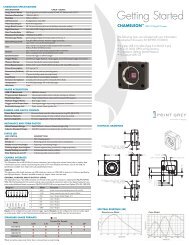You also want an ePaper? Increase the reach of your titles
YUMPU automatically turns print PDFs into web optimized ePapers that Google loves.
Point Grey <strong>Blackfly</strong> Technical Reference<br />
9 Troubleshooting<br />
9.4 Blemish Pixel Artifacts<br />
Cosmic radiation may cause random pixels to generate a permanently high charge, resulting in a permanently lit, or<br />
'glowing,' appearance. Point Grey tests for and programs white blemish pixel correction into the camera firmware.<br />
In very rare cases, one or more pixels in the sensor array may stop responding and appear black (dead) or white<br />
(hot/stuck).<br />
9.4.1 Pixel Defect Correction<br />
Point Grey tests for blemish pixels on each camera. The mechanism to correct blemish pixels is hard-coded into the<br />
camera firmware, and can be turned off and on by the user. Pixel correction is on by default. The correction algorithm<br />
involves applying the average color or grayscale values of neighboring pixels to the blemish pixel.<br />
Pixel correction is not done in any of the binning modes (page 42).<br />
Related Knowledge Base Articles<br />
Title<br />
Article<br />
How Point Grey tests for white blemish pixels Knowledge Base Article 314<br />
Access this feature using:<br />
CSR<br />
PIXEL_DEFECT_CTRL: 1A60h<br />
9.5 Rolling Shutter Artifacts<br />
The rolling shutter used on the CMOS sensor of the camera may produce undesirable effects under certain<br />
conditions.<br />
Skew—Skew occurs if the camera is panning horizontally while the sensor is still exposing making vertical objects<br />
appear to be leaning. Skew can be minimized by slowing the pan or increasing the frame rate (or both).<br />
Wobble—Wobble is a stretching of objects due to vibration or sudden motion of the camera or the object. Wobble<br />
can be minimized by increasing the frame rate or slowing the shutter speed; however, the wobble effect is then<br />
masked by motion blur.<br />
Partial Exposure—Partial Exposure occurs when a sudden change of lighting, such as a flash, significantly alters the<br />
exposure, but only for a portion of the frame. This results in dark and bright horizontal bands. Partial Exposure can be<br />
minimized by synching the light source to the exposure.<br />
Related Knowledge Base Articles<br />
Title<br />
Article<br />
Key differences between rolling shutter and frame (global) shutter Knowledge Base Article 115<br />
Revised 12/13/2012<br />
Copyright ©2012 Point Grey Research Inc.<br />
64











